BELL SYSTEM PAVILION
NEW YORK WORLD'S FAIR 1964-1965
A Chair ride through a series
of scenes which show the story of communications. After being
seated comfortably in your own contour chair -- each fitted with
its own separate sound system -- you will see the miracles --
and progress of communications come alive during the next 14 minutes
through such new theatrical techniques as three dimensional stage
and film settings, and front and rear projections of still and
motion pictures -- all accompanied to original music by Morton
Gould with lyrics by Joseph Langland.
|
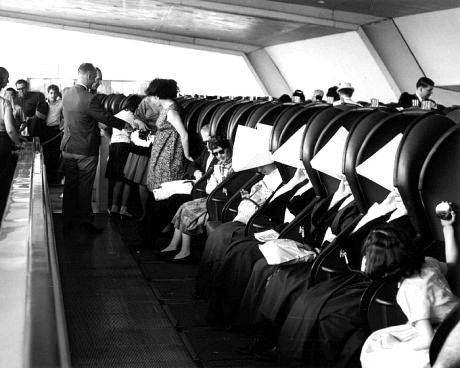
Source: A.T.& T. Photo
Archives
|
Cocoon Seating
|
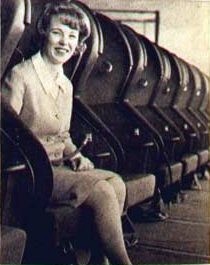
|
Cocoon-like, glass fiber seating has been
developed for Bell Telephone pavilion. Interior of seat is covered
with nylon upholstery and full foam seat and back. Interior also
includes thin, acoustical absorbent urethane foam underneath
cotton jersey fabric. Seats number 1000 are mounted on conveyor
belts that take people through Bell's exhibit. They have green
exterior and blue interior. American Seating Co., 901 Broadway,
Grand Rapids, Mich. |
Source: American Seating
Co. advertisement, publication unknown
Bell System Ride
| The complete story of communications is
told in a 10-minute ride through 50 three-dimensional scenes,
into which are projected film characters. This ride is one of
the Fair's really big A-V stories ... it incorporates a 104-foot
special black material screen supplied by the Trans-Lux Corporation.
LEFT: Battery of 65 16mm Norelco projectors in the Bell Systems
pavilion. They provide the show for Bell's "1,000 chair
ride." |
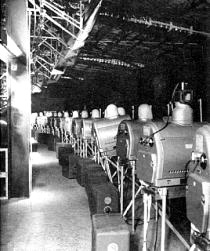
|
Source: Industrial Photography,
Vol. 13 No. 5, May 1964 |
BELL SYSTEM PAVILION
-
-
armchair "sound
ride" takes 1,000 viewers on film journey "From Drumbeat
to Telstar"
The Bell System Pavilion is a 400-foot "floating
wing" which offers a chair ride and series of live demonstrations.
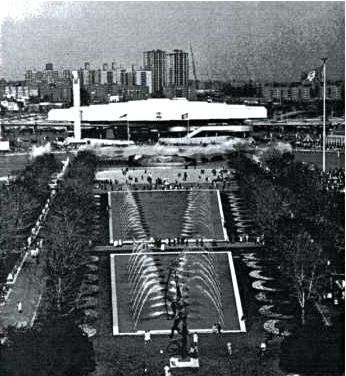 |
|
THE "RIDE" in the
Bell System Pavilion is one of the most complex and interesting
film experiences of the Fair. The 1,000 moving armchairs with
built-in speakers in two continuous loops of 500 each on two
levels carry spectators through a 15-minute program which involves
65 motion pictures on individual screens.
Titled From Drumbeat to Telstar, the program takes
us from man's first efforts to communicate -- with voice, drumbeats,
smoke signals -- on through the discovery of symbols, numbers,
the written word and modern developments -- the telephone and
Telstar. The story is told by speakers synchronized to the action
on the screen for each individual chair.

|
Familiar visitor's line awaiting turn along
Bell's ride. Crowd control is very good here.
|
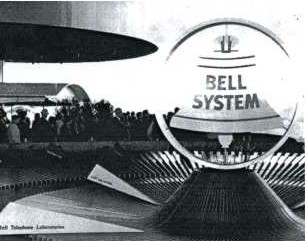
|
|
The ride was conceived by the Pavilion's designer, Jo Mielziner,
working with architect Harrison & Ambramovich, motion picture
engineers -- the Reevesound Company, and the film producers,
Owen Murphy Productions.
On the 65 screens -- which cannot be seen as screens at all
since they are veiled in various thicknesses of gauze curtains
called scrims -- are short pieces of action performed by Hal
Holbrook, noted stage actor of "Mark Twain" fame.
|
|
Mr. Holbrook will be seen calling "hello" in an early
part of the ride, sending smoke signals, inventing the printing
press or the telephone. It takes an average of six seconds for
each chair to pass each individual screen (although many of the
screens are grouped in a single tableau). On the screens are
endlessly repeated actions on looped films which run from six
to 15 seconds. |
Sound-equipped upholstered chairs which carry
visitors along the ride.
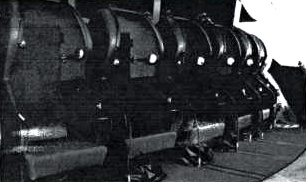 |
|
|
What is amazing about this is that there is no point at which
the action can be seen to obviously stop and repeat itself --
no jerks at the splices to spoil the smoothness.
Director Paul Cohen, of Owen Murphy Productions, achieved
this by working with Mr. Holbrook until he was able to perform
an action "forward" and then smoothly continue "backward"
to the point of origination of the action. In other words, he
would pick up a pen, write a few words, fold the paper, and lay
it aside. Then he would continue right on doing the same thing,
but backwards.
With this forward and backward action on film, editors could
then print the "forward" portion straight, reverse
print the "backward" portion, and splice almost anywhere
in the action without it being noticeable on the screen. If this
sounds complicated, it most assuredly is, but it works.
To achieve the effect of having none of the screens visible,
Designer Joe Mielziner has used multiple scrims before each one,
and the figures in the film are performing entirely with limbo
backgrounds. There are no frame lines anywhere visible. This
was accomplished by photographing the action on a blue cyclorama
set. Then, by printing this through a blue filter, a matte exactly
matching the action is obtained. Printing both together produces
a film with no background, no frame lines, and the character
entirely in limbo.
|
Scenes for the 65 loop films which carry the
story of "From Drumbeat to Telstar" along the chair
ride are seen through scrims of varying styles, thickness so that
there is no apparent background, no visible frame lines. Resulting
fuzziness (at time) doesn't improve quality.
|
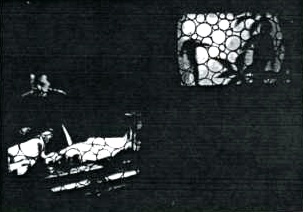
|
|
Each of the 65 loops in the program is changed daily. It is
estimated that an average loop goes through 5,000 runs during
the 12-hour day before it is discarded. For the producer, this
means a regular editing staff constantly preparing new loops
for the projectors.
With all these extraordinary complexities, it is a tribute
to the designer, producer and engineers that the Bell System
ride started operating at 10 AM on the opening day of the Fair
and has continued with no breakdowns ever since. The Pavilion's
percentage of visitors has steadily increased and From Drumbeat
to Telstar seems settled into a long, successful run.
|
-
-
Design and Engineering
of the Bell Show
-
-
Battery of 65 Norelco 16mm projectors lines
up along slightly curved ramp behind the 1,000 chair ride in the
Pavilion. Overhead-first-surface mirrors increase projection distance
and image size.
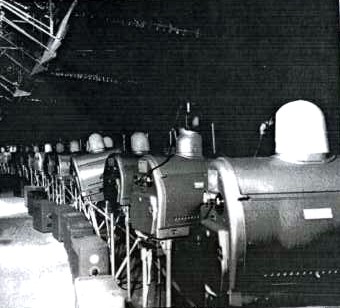 |
|
DESIGN AND ENGINEERING installation
in the Bell System Pavilion was a major task in itself, primarily
centering on the 1,000 chair "sound" ride which occupies
a mobile ramp in the "floating" wing of the wide structure.
Produced by Jo Mielziner of New York, this unusual theatrical
presentation has projection and sound systems of unique capability
which were created by Reevesound. A monaural sound system of
special two-ear design is built into each of the 1,000 upholstered
lounge-type chairs.
This sound system utilized two tracks on Reevesound's four-track,
sixteen-millimeter reproducing system, with like programs being
fed through right and left ear speakers, positioned at the upper
inside of the chairs. Individuals are provided with a sound program
that is synchronized with the ride.
|
|
Reevesound's projection system in the cavern includes a battery
of sixty-five 16mm Norelco projectors equipped with 1600 watt
Zeiss Xenosol II light sources, first-surface mirrors, continuous
duty synchronous motors and specially designed film loop supports.
Projectors, lamps, rectifiers and loop racks are located on
long platforms behind a series of rear projection screens. A
first-surface mirror placed at the front of each projector mechanism
receives light from the projector, redirects it to similar, larger
mirrors positioned overhead, which transfer light to rear projection
screens ahead. This system of mirror optics is used to increase
projection distance and image size.
This combination of continuous 16mm film loops, synchronous
motors and Xenon lamps gives the Reevesound system long operating
life with minimum maintenance requirements on film and projection
equipment.
|
Closeup of one of the 65 Reevesound-modified
16mm Norelco projectors used along chair ride in the Bell Pavilion.
Each projector is equipped with 1600-watt Zeiss Xenosol-II lighting
source, a first-surface mirror and the 16mm film "loop"
rack which can be seen at left in scene.
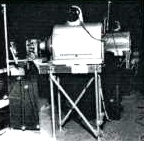 |
|
Source: BUSINESS
SCREEN MAGAZINE Presented courtesy Eric Paddon Collection
|
Exterior of small "stand-up"
theater in main downstairs exhibit area. Audiences of 80-100 persons see a multi-screen slide presentation
on many facets of telephone service; show is repeated every 15
minutes
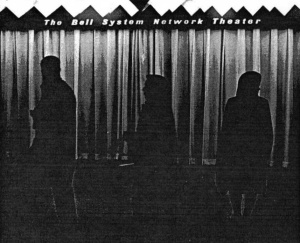 |
Inside the "stand-up theater: the
slide show utilizes colorful lighting effects, Technamation techniques.
Scenes come up on several panels individually and "en masse"
through both front and rear projection.
 |
|